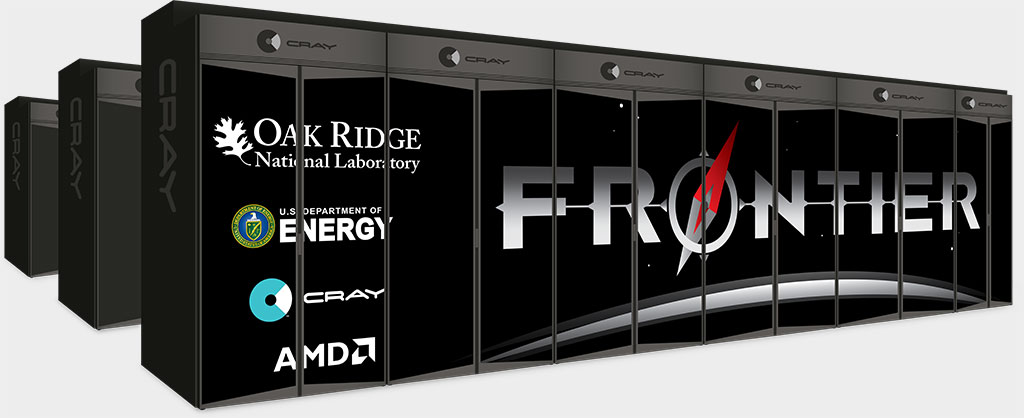In 2021 the world’s fastest supercomputer will weigh more than 1 million pounds
AMD is working with Cray to build Frontier, a supercomputer capable of a staggering 1.5 exaflops.

If all goes to plan, the fastest supercomputer in the world will run on AMD hardware in a couple of years, including both AMD-built processors and graphics chips. Called "Frontier" and set to debut in 2021, the AMD-powered supercomputer promises to deliver a record-setting 1.5 exaflops of performance.
The US Department of Energy has tapped AMD and Cray to build what would be considered the world's first exascale supercomputer. That works out to 1.5 quintillion calculations per second, which is up to 50 times faster than today's top supercomputers. We don't have all the specifics, but it appears AMD is quoting full double-precision FP64 performance (eg, not something done via FP16 Tensor cores).
"Frontier’s record-breaking performance will ensure our country’s ability to lead the world in science that improves the lives and economic prosperity of all Americans and the entire world," said US Secretary of Energy Rick Perry. "Frontier will accelerate innovation in AI by giving American researchers world-class data and computing resources to ensure the next great inventions are made in the United States."
This won't be used for gaming, obviously, though there is certainly enough horsepower to run multiple instances of Crysis, if that was the goal. It's not. Frontier will be tasked with delivering breakthroughs in scientific discovery, along with workloads related to the economy, energy, and national security.
For AMD, this is validation that it can compete on the highest stage. Many of the supercomputers in the Top500 list have Intel hardware inside. At the very top, however, the two fastest machines—Summit and Sierra—both run a combination of IBM an Nvidia hardware.
Frontier will turn the tables on the usual suspects by incorporating custom AMD Epyc processors based on Zen 2 with Radeon Instinct GPUs specifically designed for exascale computing. It's not clear what the underlying architecture of the GPUs will be based on (most likely a variant of Navi), though the DOE did say Frontier will feature blades supporting a 4:1 GPU to CPU ratio, with high-speed AMD Infinity Fabric links. In other words, four GPUs for every CPU.
AMD is obviously excited about the venture, as it should be. It's yet another design win, to go along with powering the upcoming PlayStation 5, and probably the next Xbox as well.
Keep up to date with the most important stories and the best deals, as picked by the PC Gamer team.
"AMD is proud to be working with Cray, Oak Ridge National Laboratory, and the Department of Energy to push the boundaries of high performance computing with Frontier," said Dr. Lisa Su, AMD president and CEO. "Today’s announcement represents the power of collaboration between private industry and public research institutions to deliver groundbreaking innovations that scientists can use to solve some of the world’s biggest problems."
On the CPU side, Zen 2 is actually the third-generation of Zen, and is built on a 7-nanometer manufacturing process. It succeeds Zen+ (12nm) and Zen (14nm). On the desktop, Zen 2 will power AMD's upcoming Ryzen 3000 series processors, which are expected to be offered with up to 16 cores and 32 threads for mainstream consumer platforms.
As for why the DOE chose AMD for its next supercomputer, analyst Patrick Moorhead told CNET it's probably because of the company's Infinity Fabric technology, which enables a fast connection between CPUs and GPUs.
"This bodes well for AMD's future as this is technology that should be in the mainstream market after 2021," Moorhead said.
That doesn't mean we'll be playing games on exascale computers in the near future. However, it's a strong indication that AMD is on the right track, both its near- and long-term roadmaps.
Whether the $600 million Frontier supercomputer emerges as the first exascale system remains to be seen. The race is on between the US and other nations to cross the 1-exascale threshold. Even if not, however, Frontier is expected to be faster than whatever comes first.
An interesting side note is how enormous Frontier will be. During press conference, Pete Ungaro, Cray's chief executive officer, said Frontier will be about the size of two basketball courts, weight more than 1 million pounds, and have more than 90 miles of cabling.
Paul has been playing PC games and raking his knuckles on computer hardware since the Commodore 64. He does not have any tattoos, but thinks it would be cool to get one that reads LOAD"*",8,1. In his off time, he rides motorcycles and wrestles alligators (only one of those is true).


